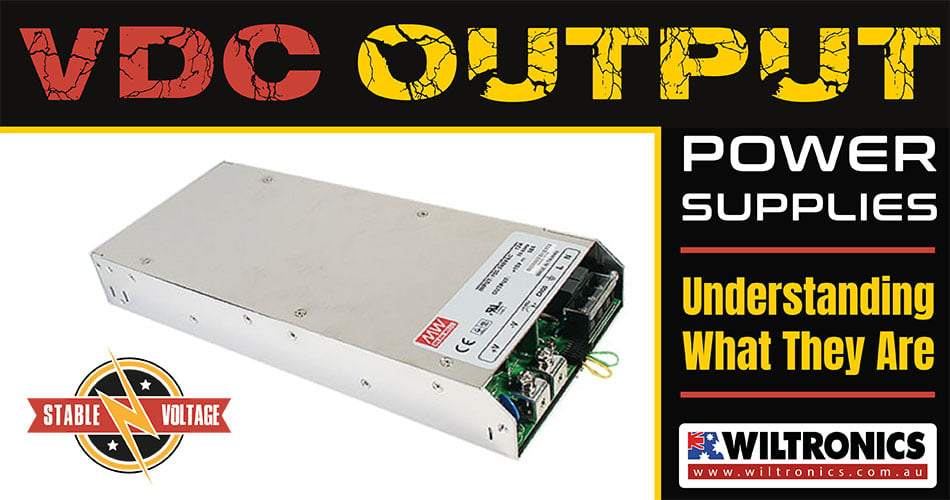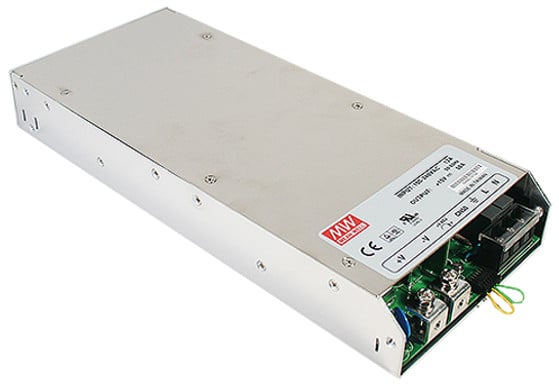Understanding What VDC Output Power Supplies Are
June 8, 2023

Power is the pillar of every electronic system, and at its core lies the power supply. Selecting the ideal supply can make all the difference in terms of how a device operates. Whether at its peak performance or faltering with inconsistent outcomes.
Among the various types of power supplies, VDC has gained significant importance. But what is it, and why is it important? In this guide, we will uncover the fundamental concepts behind VDC output.
Power Supply Explained
A power supply is an electrical device that powers the load with proper voltage (V) and current (I). It converts the current from a power source, e.g. mains, into precise (V) and (I) required to power various loads, e.g. a device.
A power supply can be external, often seen in devices such as phone chargers and laptops. Or internal, such as desktop computers. Moreover, it can either be regulated or unregulated.
In a regulated power supply, the changes in the input voltage do not affect the output. In an unregulated one, in contrast, the output depends on any changes in the input.
And the power at the input and output can be alternating current (AC) or direct current (DC):
- Alternating current (AC) occurs when the electric current periodically inverts its direction. It delivers electricity through power transmission lines to homes and businesses. Simply put, it is the type of power delivered to your house.
- Direct current (DC) occurs when the current flows in one constant direction. It comes in the form of batteries, solar cells, or AC/DC converters. DC is basically the power you need to charge your phone or any device with portability on its feature list. Virtually all electronic devices use DC, which makes VDC output the most widely used.
Understanding the concept of power supplies is the first step before exploring VDC. It provides know-how in the conversion and distribution of energy to power devices. This also sets the stage for learning the characteristics of VDC output.
Decoding VDC Output Power Supplies
VDC stands for volts direct current, and it can come in the form of a battery or a power supply. It is a current that flows in a single direction, maintaining a constant voltage level. Unlike AC, which periodically changes direction, VDC provides a consistent power source.
This stability is one of its great advantages. It is often used in various electronic devices and systems due to it. Moreover, it is associated with power supplies that convert AC from the mains into DC.
Typically, a VDC output is a simple AC-to-DC converter that has a power supply voltage of 110 or 220 VAC. It converts this into 3V, 5V, 9V, 12V, or 24V. This indicates the level of voltage output provided by the power supply. Overall, VDC power supplies are available in various configurations, sizes, and output levels.
VDC Output Power Supply Type
VDC power supplies can be broadly classified into two main types: linear and switch mode. Here is an overview of each type:
Linear Power Supply
Linear power supplies are known for their simplicity and low-cost design. They operate by using a linear regulator to regulate the voltage. These power supplies typically consist of the following:
- transformer
- rectifier
- filtering components
- a linear regulator
The transformer steps down the voltage from the input source. The rectifier converts AC to DC. The linear regulator controls the output voltage to provide a stable VDC output.
Overall, linear power supplies are relatively quiet and have low output ripple. But note that they are less efficient as they dissipate excess energy as heat.

Switch mode power supplies (SMPS) are known for their high efficiency and compactness. They utilise a switching regulator to control the voltage output.
SMPS employ a more complex circuitry that involves high-frequency switching of power transistors. This switching action allows for efficient voltage conversion and regulation.
SMPS power supplies are lighter, more energy-efficient, and generate less heat. They are used in various e-devices, e.g. computers, TVs, and industrial equipment.
While both can provide VDC output, their design, efficiency, and performance characteristics differ. The choice between these types also depends on factors such as:
- Cost
- Efficiency requirements
- Size constraints
- Specific application needs
The Advantages and Disadvantages
VDC output power supplies offer several pros and cons. Here are some of the key points to consider:
Advantages
- Stability and precise voltage regulation. VDC power supplies provide a stable and regulated voltage output. This ensures consistent and reliable operation of electronic devices.
- Compatibility with electronic devices. Many electronic devices and components require VDC input. These include microcontrollers, sensors, and integrated circuits. VDC power supplies are designed to meet these voltage requirements.
- Flexibility in voltage selection. VDC power supplies are available in various voltage options. This allows for compatibility with a wide range of electronic devices and applications.
- Noise reduction. VDC power supplies often incorporate filtering mechanisms. It minimises electrical noise and ripple in the output. This results in cleaner power for sensitive electronic components.
Disadvantages
- Efficiency and heat dissipation. Traditional linear VDC can be less efficient compared to switch-mode power supplies. For one, they dissipate excess energy as heat.
- Size and weight. Linear VDC power supplies can be relatively larger and heavier. This makes them less suitable for compact and portable electronic devices.
- Cost. Linear VDC power supplies are generally more cost-effective. However, the cost may increase for high-power applications or specialised requirements.
The Bottom Line
VDC output power supplies provide stable voltage, precise regulation, and compatibility. From powering consumer electronics to automotive components, you name it. The knowledge of VDC output empowers you to make informed decisions and ensure optimal performance.
© Electrotech Brands Pty Ltd 2023


Write a Comment
You must be logged in to post a comment.